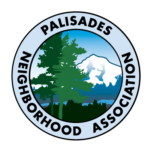- The severe overloading of the roundabout at Stafford/Atherton/Rosemont will send more vehicles into the Atherton neighborhood (Meadowlark-to-Atherton) to enter Rassekh Park, and that is a safety concern for that neighborhood.
- The Stafford/Atherton/Rosemont roundabout’s Level of Service (LOS) is currently an “F”, while the city’s minimum acceptable LOS is “E”. The Traffic Impact Analysis prepared by PBS, dated 2/23/21, concludes that the LOS at this roundabout will be an even more severe “F” once the 3 projects (Golf Course, LORAC, and Rassekh Park) are completed.
- The TIA has taken a significant reduction of future LORAC traffic by assuming that future golf course traffic will be significantly less than it is today. This reduction of LORAC’s future traffic is shown in table 4, “Trip Credits (18 to 9 hole Golf Course)”, on page 9 of the TIA, and equates to <17%> for AM Peak Hour Trips, <22%> for PM Peak Hour Trips, and <48%> for Saturday traffic. This doesn’t make sense intuitively, and is inconsistent with comments made by Ken Rehms, Civil Engineer, and Bruce Powers, LO Project Manager, at the Golf Course Informational meeting of August 3 – that traffic for the renovated golf course would be the same or, perhaps just slightly less. The city’s online open house website for the Renovated Golf Course states, “The proposed course is made up of nine holes and includes Par 3 and Par 4 holes. The variety of this course will attract more golfers to this course and meet the needs of the local golfing market”.
- The AM and PM peak hour figures for the roundabout (line 1 on table 7, page 14 in the TIA) for future traffic and the LORAC project combined, are the same as the figures in table 8 (page 16) for future traffic at both LORAC and Rassekh. This can’t be the case.
- We are requesting that the assumed reductions in traffic for the new golf course be eliminated, that the error in table 8 be reviewed and fixed, and the models be re-run for all three projects combined.
- The city must develop a solution to improve the roundabout (PBS’s recommended solution on p.17 seems to make sense), with funding in place before these three projects are started. The improved roundabout work should be completed before the 3 projects are opened to the public to ensure the safest possible traffic/pedestrian conditions.
- The combined budget for the 3 projects is approximately $45 million. It would seem reasonable that a small % of that budget, plus whatever funding the city can secure from Clackamas County, be directed to solve a failing roundabout that is already creating a dangerous situation and will only become more dangerous once Rassekh’s pedestrian traffic is added.
- After all projects are built we will have 12 fields within a quarter-mile of the Overlook/Stafford intersection. Athletes will use those fields primarily between 3:30 PM (after school) and 8 PM. This hits the PM commute traffic and highlights the error in PM commute delay metrics in the TIA.
- To proceed with 3 large capital projects which will further overload a critical arterial roundabout without a rational plan to mitigate that impact, is irrational.


